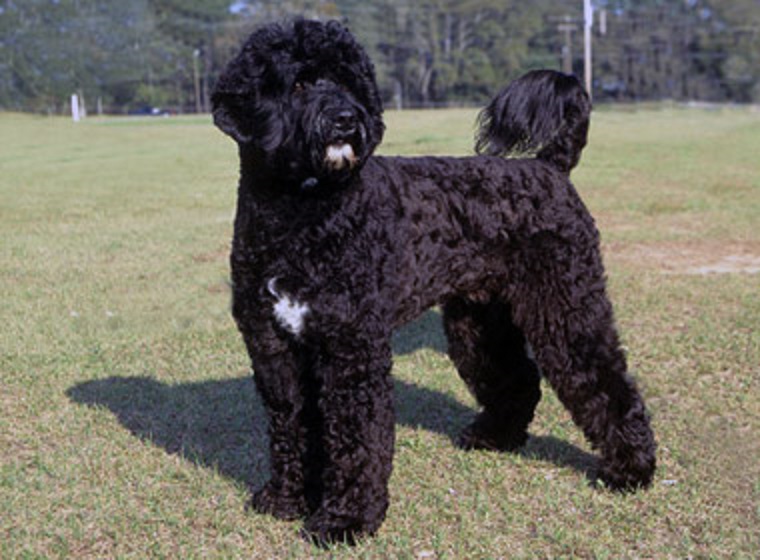
Portuguese Water Dog

Navigate through the tabs
Navigate through the tabs below to view the breed's info of your interest.
The breed's info is divided in four sections; namely:
the breed's history ,
the breed's main stats ,
the dog's potential health issues
and finally, how the breed scored in 26 different categories.
All the above information should give you a respectively good overview for the dog of your interest.
Dog Breed's Main Info
The Breed's History:
One theory is that some of the rugged Asian herding dogs were captured by the Berbers, people who spread slowly across the face of North Africa to Morocco. Their descendants, the Moors, arrived in Portugal in the 8th century, bringing the water dogs with them.
Another theory proposes that some of the dogs left the Asian steppes with the Goths, a confederation of German tribes. Some, (the Ostrogoths), went west and their dogs became the German poodle, called in German the poodle-hund or puddle-dog, that is, water-dog.
Others, (the Visigoths), went south to fight the Romans, and their dogs became the Lion Dog, groomed in the traditional lion cut. In 413 CE, the Visigoths invaded Iberia (modern Spain and Portugal, then known as Hispania) and the dogs found their homeland before being settled in Aquitania north of the Pyrenees in 418 before extending their rule to most of Iberia after 470 CE.
A Portuguese Water Dog is first described in 1297 in a monk's account of a drowning sailor who was pulled from the sea by a dog with a "black coat, the hair long and rough, cut to the first rib and with a tail tuft".
These theories explain how the Poodle and the Portuguese Water Dog may have developed from the same ancient genetic pool. At one time the Poodle was a longer-coated dog, as is one variety of the Portuguese Water Dog. The possibility also exists that some of the long-coated water dogs grew up with the ancient Iberians. In early times, Celtiberians migrated from lands which now belong to southwestern Germany.
Swarming over the Pyrenees, circulating over the whole of western Europe, they established bases in Iberia, as well as in Ireland, Wales, and Brittany.
The PWD was a breed on the verge of extinction when, during the 1930s, Vasco Bensaude, a wealthy Portuguese shipping magnate, began to seek out fishermen's dogs and utilize them in a breeding program to re-establish the breed.
Bensaude's kennel was named Algarbiorum, and his most famous dog was Leao (1931-1942), a very "type-y" (i.e., standard-conformant) fisherman's stud dog, who was bred to so many different females that about half of the pedigreed Portuguese Water Dogs in existence can trace their lineage back to him.
Bensaude was aided by two Portuguese veterinarians, Dr. Francisco Pinto Soares and Dr. Manuel Fernandes Marques. His work was carried on by Conchita Cintron de Castelo Branco, to whom he gave his last 17 PWDs and all his archives.
Dr. Antonio Cabral was the founder of the Avalade kennels in Portugal. Ch. Charlie de Avalade (Charlie), a brown-coated dog, and C. B. Baluarte de Avalade (Balu) were two of his many famous PWDs. He registered his first PWD in 1954, after Bensaude had pioneered the re-establishment of the breed in Portugal. Cabral worked with Carla Molinari, Deyanne Miller, Sonja Santos and others to establish PWDs in the US.
The "Mark of Cabral" is a triangular shape of different color/textured hair, usually 2 to 3 inches (5 to 8 cm) from the base of the tail.
Deyanne Miller is the person most responsible for the rise of the PWD in America. In 1972, the Millers, along with 14 others, formed the Portuguese Water Dog Club of America, Inc. (PWDCA). She worked with dogs from both the Cintron and Cabral lineages to establish a stable genetic pool of PWDs in the US at her Farmion kennels. Another early US breeder of PWDs was the actor Raymond Burr.
Country of Origin:
Portugal
Breed Group:
Working
Height:
1 foot, 5 inch. to 1 foot, 11 inch. (43,18 to 58,42 cm)
Weight:
35 to 65 pounds (15,87 to 29,49 Kg)
Life Span:
10 to 14 years
Potential Health Issues:
Juvenile Dilated Cardiomyopathy,
Hip Dysplasia,
Storage Disease (GM1),
Progressive Retinal Atrophy (PRA)
Adaptability
Apartment Living:
First Time Owners:
Sensitivity:
Being Alone:
Cold Weather:
Hot Weather:
Friendliness
Affection With Family:
With Kids:
With Dogs:
With Strangers:
Health and Grooming
Shedding:
Drooling:
Easy To Groom:
Overall Health:
Weight Gain Potential:
Size:
Training
Easiness:
Intelligence:
Mouthiness:
Prey Drive:
Barking or Howling:
Wanderlust:
Need For Exercise
Energy Level:
Intensity:
Exercise Needs:
Playfulness:
Our Mobile Application
Check out Our Mobile Application "Dog Breeds Central"
